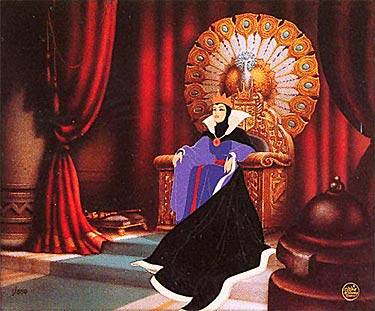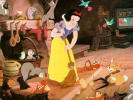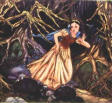 Snow
White
Snow
White  Snow
White
Snow
White In Section 20, we get an extended portrait of the Disney studio at its height. What made Disney a popular employer among his employees? On p. 176, Schickel states his thesis for this entire chapter; what is it that Disney was after in his animation? What impacts (good and bad) would this eventually have on his studio and its products? You should also note which two styles of animation were paramount in Disney animation of this time and which one Walt himself preferred. In training his animators at the studio, what was Disney aiming for? What unintended result did he also produce through this increasingly standardized training? Finally, how did a sense of alienation gradually grow in a studio which initially encouraged (and got) a high level of professional commitment from its artistic employees?
Section 21 charts the growing rigidity of the structure and style of the studio, both in terms of art and in terms of technology. At its center is perhaps Disney's own statement, "When we do fantasy, we must not lose sight of reality." What did he mean by this and what are the statement's implications for this kind of animation he would continue to produce as the '40s and '50s rolled on? How is the distinction between artistic vision and reductive realism explained in the text? What does it have to do with "the Disney version"? What technology was Disney developing during this period and what was his reason for doing so? By the end of this section, you should be focused on the reasons why the Warner Brothers cartoons were able to pass Disney's in both artistic interest and popular support by the mid-1940s. What had happened to both animated shorts and animated features at Disney by the end of the 1950s?
In Section 22, we return to the idea of "the Disney version," particularly the Disney version of folk and fairy tales. What, according to Schickel, are the strengths of folk and fairy tales as we find them in literature? What about such tales as Snow White made generation after generation remember them and pass them on to their children? What collective wisdom were they intended to pass on? The section concludes with a look at the growing sense of nostalgia for a remembered past in American culture early in the century, and you should be ready to give some examples of how it may have affected Disney. (Since our own time seems equally immersed in a similar nostalgia, you shouldn't have much trouble recognizing it.)
Section 23 concludes the
chapter by first detailing the production of Snow White, with a useful
emphasis on exactly what kind of gamble Disney was taking in producing it. You
should be quite familiar with this production history, as well as which the
interesting list of cha nges
Disney made to the original story before presenting it to the American people
in 1937. Is there any pattern you can see in Disney's excisions and shifts of
emphasis? Schickel characterizes the film as "a major cinematic achievement,"
but also finds the seeds of Disney's later failures in it. What were the faults
that would become larger and more debilitating to the Disney version that would
come after? Schickel quotes critic Gilbert Seldes in comparing The Band Concert
to more fairy tale oriented Silly Symphonies that prefigure Snow White;
which style of cartoon does Seldes prefer? What can we learn from the comparison?
As he prepares to conclude the chapter, Schickel defines the term "Disneyfication"
as "that shameless process by which everything the studio later touched,
no matter how unique the vision of the original from which the studio worked,
was reduced to the limited terms Disney and his people could understand. Magic,
mystery, individuality--most of all, individuality--were consistently destroyed
when a literary was passed through this machine that had been taught there is
only one correct way to draw." How accurate do you feel this assessment
to be? When someone adapts a text to a new medium, changes are inevitable, but
what does Jonathan Miller believe the adaptation must create on its own? We
end with a very interesting comment from mythologist Joseph Campbell on p. 226;
be ready to talk about his ideas in class.
nges
Disney made to the original story before presenting it to the American people
in 1937. Is there any pattern you can see in Disney's excisions and shifts of
emphasis? Schickel characterizes the film as "a major cinematic achievement,"
but also finds the seeds of Disney's later failures in it. What were the faults
that would become larger and more debilitating to the Disney version that would
come after? Schickel quotes critic Gilbert Seldes in comparing The Band Concert
to more fairy tale oriented Silly Symphonies that prefigure Snow White;
which style of cartoon does Seldes prefer? What can we learn from the comparison?
As he prepares to conclude the chapter, Schickel defines the term "Disneyfication"
as "that shameless process by which everything the studio later touched,
no matter how unique the vision of the original from which the studio worked,
was reduced to the limited terms Disney and his people could understand. Magic,
mystery, individuality--most of all, individuality--were consistently destroyed
when a literary was passed through this machine that had been taught there is
only one correct way to draw." How accurate do you feel this assessment
to be? When someone adapts a text to a new medium, changes are inevitable, but
what does Jonathan Miller believe the adaptation must create on its own? We
end with a very interesting comment from mythologist Joseph Campbell on p. 226;
be ready to talk about his ideas in class.
Snow White
Starting  with
its traditional "opening of the storybook," Snow White aims to take us into
a technicolor world of jewel-like colors where princes show up on cue and wicked
stepmoms always end up in the pit. From its opening shots of the castle, the
film is photographed as if it were a live-action film. As the camera tracks
slowly in toward the castle, it centers on an oval window which dissolves into
the mirror
in the Queen's chamber. From the flames a moving mask (with all its implications
of deception) talks to us as if we were in the place of the Queen. Not only
is the mise-en-scene highly cinematic, then, it is also highly metaphoric, particularly
in the nightmarish scenes in which the Queen appears.
with
its traditional "opening of the storybook," Snow White aims to take us into
a technicolor world of jewel-like colors where princes show up on cue and wicked
stepmoms always end up in the pit. From its opening shots of the castle, the
film is photographed as if it were a live-action film. As the camera tracks
slowly in toward the castle, it centers on an oval window which dissolves into
the mirror
in the Queen's chamber. From the flames a moving mask (with all its implications
of deception) talks to us as if we were in the place of the Queen. Not only
is the mise-en-scene highly cinematic, then, it is also highly metaphoric, particularly
in the nightmarish scenes in which the Queen appears.
Since we're watching the movie this week, I'm giving you some of my observations and questions to help you focus yours as you watch. We'll pick up from here in talking about this movie, which certainly changed the course of animation art and history. Snow White appears in rags (for reasons that aren't completely clear), but she has apparently found a new outfit by the next day when she wanders into the woods. She is wishing for a rescuer--and one comes immediately over the wall.
Hollywood films have always placed great emphasis on heterosexual romance as a model for order and unity in the world; the Romeo and Juliet scene on Snow's balcony certainly reinforces that. If Snow White is intended to be a model for young girls in the 1930s, what can we deduce about the qualities to be valued in that time and place? Throughout the movie, she is contrasted with the Queen, both in body type and in personality/character. The Queen's vanity is signaled by her appearance on her peacock throne, but our first sight of Snow also includes her pleasure in seeing herself reflected in water. You might, then, look for similarities as well as differences between these two women.
As Snow White enters the depths of the forest, fleeing the Queen, the previously realistic mise-en-scene becomes surreal. Trees turn into creatures from the id, she tumbles into endless falls and is caught by grasping claws. In short, Snow's psychological state is made manifest by the scenery she encounters (as will the Queen's in her flight from the dwarfs at the end of the movie). When morning comes, the frightening eyes turn into cute little woodland creatures, signalling our return from the Underworld with Snow White.
One problem storytellers always have with this story is the fact that it has seven characters who are hard to differentiate from each other. The Disney Snow White came up with the idea of naming them to individualize them. How does the animation of each emphasize their character differences? Though the songs may seem saccharine to us--and Snow and her prince a little too emblematic of '30s ideas of beauty and charm--don't let that make you lose sight of the imagination and versatility of the animation, of the Disney ability to use camera movement and mise-en-scene (particularly lighting, shadows and color) to suggest psychological insights. I noted the scenes that struck me most; you should have your own list for our discussion. To get us started, I'll give you my list:
The shadows, used for
many different dramatic purposes (for humor when they precede and overshadow
the marching dwarfs; for drama when the huntsman's shadow overtakes Snow
White; for a macabre touch when we see the buzzards on the dead tree at
the end).
The painting-like quality of the scene where the dwarfs marching home along a cliff are silhouetted against the setting sun, which is still bright enough to illuminate the brilliantly sparkling waterfall to the side of the cliff.
The set design in the castle and (especially) in the dwarfs cottage, where every room reflects the dwarfs' skill as woodcarvers with endless motifs of dwarfs and animals.
The scene where the Queen descends her winding stair into the dungeon where she casts her spells. Like the dwarfs' cottage, her surroundings show enormous attention to the small details that add verisimilitude to the movie's scenes. The workroom is dark and shadowed, she exits into a dungeon with an unpleasant reminder of what dungeons are for (a skeleton forever reaching for a water pitcher just out of his/her reach) and eventually enters a subterranean river that appropriately suggests her hidden purpose in approaching Snow White. Her final scene is also very evocative, particularly the dissolve as the vultures circle.